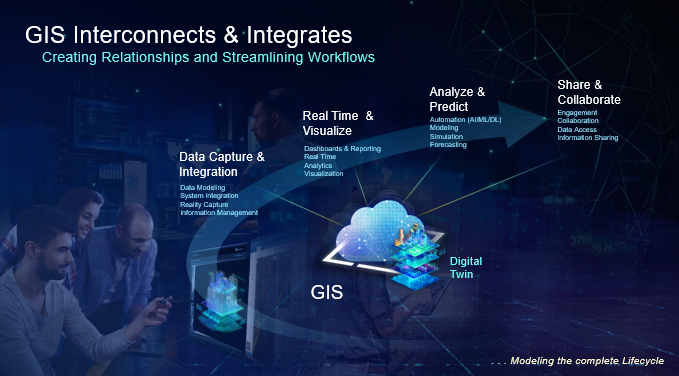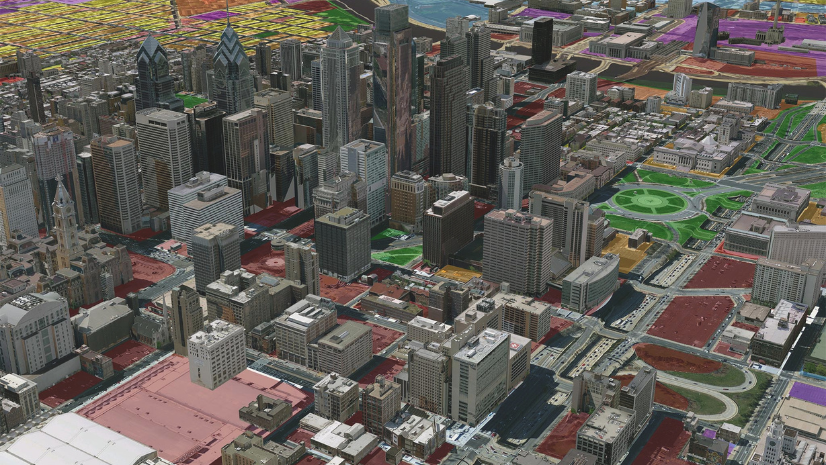Our world is transforming and rapidly becoming digital. Today, we are on the cusp of an Internet of Things (IoT)-driven technological revolution, affecting most, if not all, industries. With billions of connected sensors deployed on assets and networks and in products around the world, companies are collecting and processing data at a higher frequency and velocity. The challenge that continues to plague many organizations is how to make effective decisions from this data. Organizations are facing many new challenges and looking toward technology to improve situational awareness, create operational efficiencies, and optimize all aspects of work.
While large-scale deployments of IoT have improved the availability and timeliness of data, it can be difficult to connect these sometimes discrete and unstructured datasets. Every sensor, asset, or network has one thing in common: it is located somewhere. Location provides a common reference system to create relationships. Esri’s location technology interconnects information, systems, models, and behaviors with spatial context, creating holistic digital representations of environments, assets, networks, and cities using a modern geographic information system (GIS) infrastructure. Industry and government organizations are facing challenges in every area of their business. They work hard to adapt to and leverage digital technology. Yet they often face today’s challenges with yesterday’s methods. In the struggle to remain relevant and thrive, they are looking to update to modern advanced information technology (IT) and operational technology (OT) solutions. To achieve these transformation objectives, they need to reinvent the way they do business and change many legacy operating models and processes. To affect the desired change, organizations need scalable solutions that not only meet today’s challenges but also align to their strategic future vision. As IoT and GIS adoption increases and their applications mature, the future is becoming increasingly intelligent and automated. GIS and IoT technologies are connecting systems and data in new ways, which is enabling the transformation of many organizational workflows. The innovation and integration of these technologies are creating the nervous system and enabling real-time integrated digital twins.

Digital twins are abstracting and modeling everything. They offer a means to improve business processes, reduce risk, optimize operational efficiencies, and enhance decision-making with automation to predict outcomes. Digital twins provide greater context to meet business challenges by creating relationships and streamlining workflows.
Digital twins are used to represent accurate historical views, observe and monitor current performance, and predict future states. A digital twin of a fixed asset or real-world system benefits directly from the inclusion of GIS and IoT data about the asset. The IoT connects the data, and the GIS adds context around the asset, connecting the information model to other models and to its surroundings. GIS creates digital twins of the natural and built environment, and it can also be used to integrate many different digital representations of the real world.
In the last several years, the convergence of GIS technology; IoT; and, more recently, building information modeling (BIM) has created interactive 3D visualizations, which are redefining what a digital twin is and the value it brings to organizations. A digital twin is not a single product or solution; it is a complex network of technology and systems. It must work in harmony to achieve the desired transformational outcomes and return on investments that organizations desire. One of the powers of GIS is that it creates relationships and streamlines workflows across systems and information models. Everything has a location, which becomes the common key to integrate and model the complete life cycle. There are four steps for managing the information life cycle for a digital twin:

Data capture and integration is foundational to a digital twin. Organizations need comprehensive, end-to-end data management. They need to capture the data and model, integrate, and then manage it and its associated attributes and behaviors throughout its life cycle.
Real time and visualizations bring the data to life. Organizations can take this information and create a better understanding of what is happening now. It enables real-time situational awareness combined with advanced visualization capabilities to virtually represent how the physical components are operating in the real world.
Analyzing and predicting moves decision-making beyond just understanding the current operational state. Organizations must understand the past and view predictions into the future. They need to simulate and forecast expected outcomes as well as automate the decision-making process.
Sharing and collaboration enabled through pervasive access and accessibility on desktop and mobile devices allow information to be made available to both internal and external stakeholders. Digital twins are about sharing and collaboration of information and getting it to those who need it, when they need it.
Putting the IoT in context, it’s easy to think of it as intangible, part of the vast cloud that today largely defines our global computing infrastructure. In fact, each of the billions of sensors generating data exists in physical space. These sensors live in smartphones, in cars, on manufacturing components, and in our homes. For most of them, location is a fundamental aspect of the data they generate. Without an understanding of where a sensor is located, critical context is lacking; its value is siloed, trapped in spreadsheets and software programs. Esri’s ArcGIS location technology is a proven way to create a framework to bring data together using location and to deploy big data accurately and intelligently against real-world problems and bring IoT data to life in spatial context. GIS and IoT are the nervous system for creating digital twins.
For more information on how Esri’s ArcGIS can help meet many challenges in your organization through enabling modern digital twins, visit go.esri.com/DigitalTwin.
